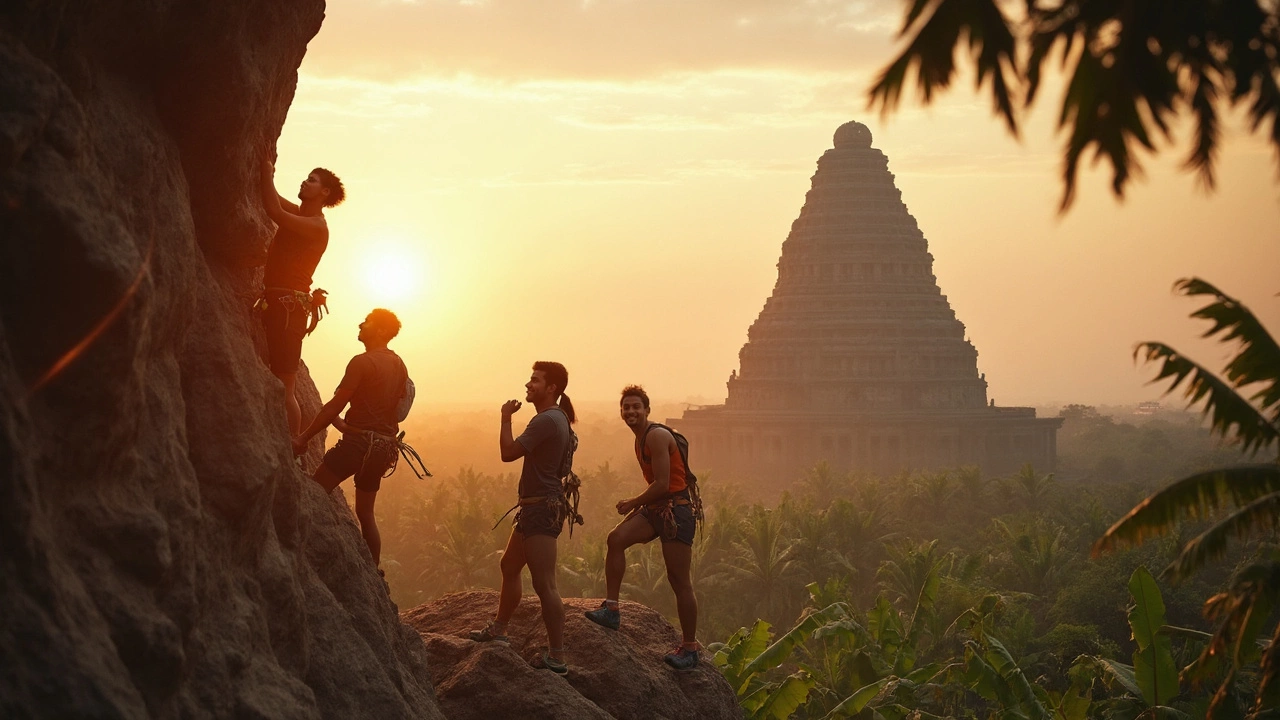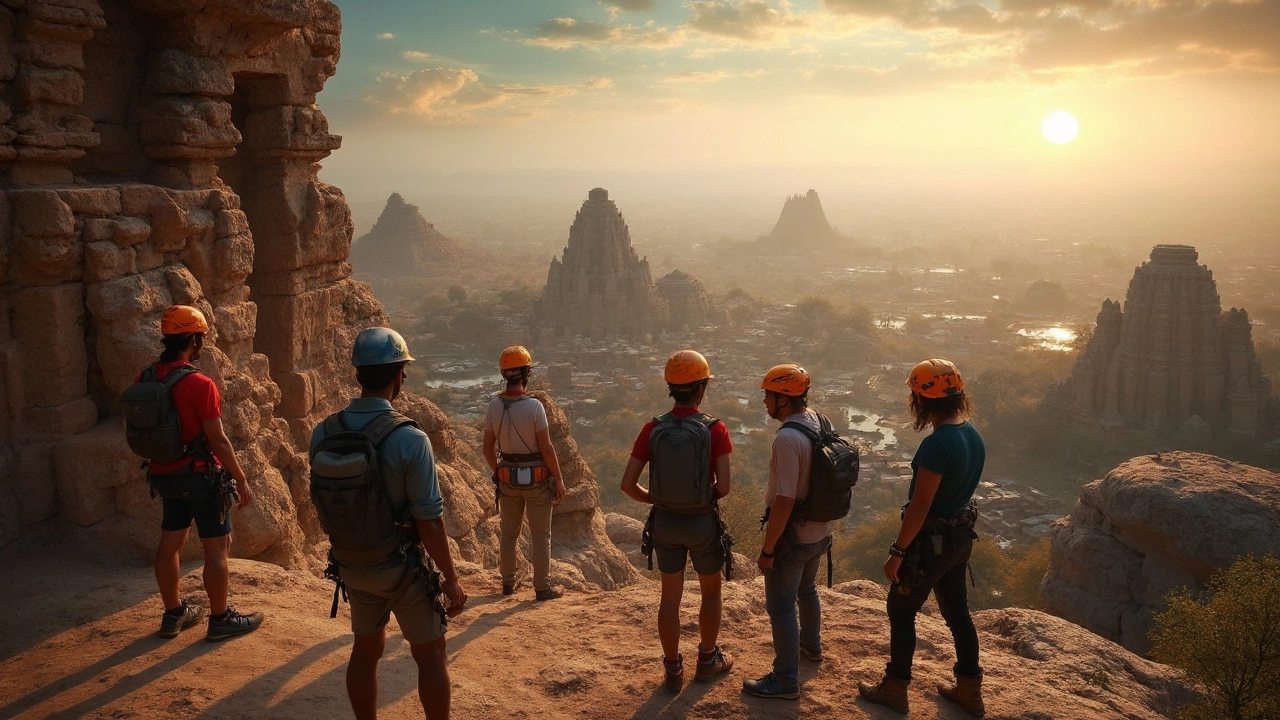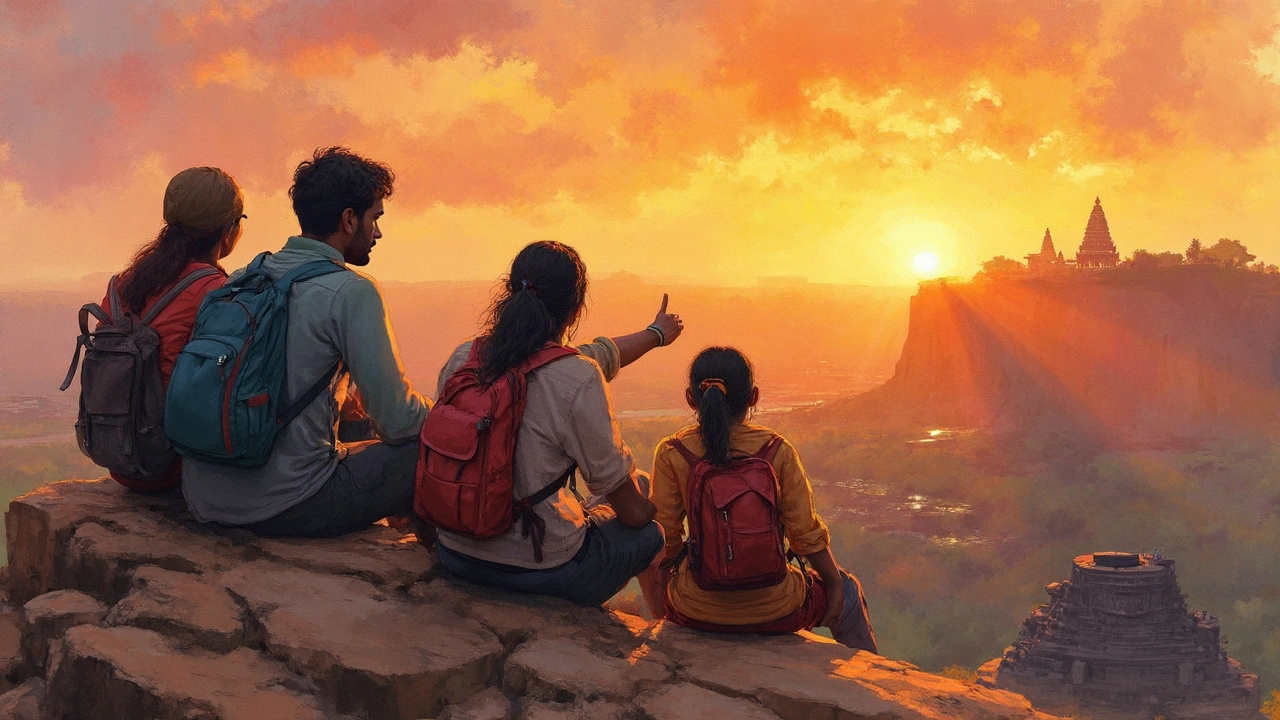Rome of India: The Surprising Adventure Sports Capital
 Jun, 22 2025
Jun, 22 2025
The phrase 'Rome of India' gets tossed around, but most people have no clue it actually means Hampi. It's not just about ancient temples and a long-lost empire. These boulders and ruins set the stage for some of the most intense adventure sports in India.
If you love scrambling up rocks or just want a little adrenaline rush, Hampi is the spot. The city is covered in giant granite rocks, making it a paradise for bouldering. You don’t have to be a pro to get started—there are friendly guides and gear rentals everywhere, so you can jump right in.
Here’s the cool part: all that climbing and exploring happens with a wild backdrop of centuries-old temples peeking out from behind the stones. This mix of adventure and history is hard to find anywhere else in the country.
- Unpacking the Nickname: Rome of India
- The Landscape That Built a Sporty Reputation
- Top Adventure Sports to Try in Hampi
- When to Go and How to Prepare
- Quick Guide: Dos and Don'ts for First-Timers
Unpacking the Nickname: Rome of India
So, why does Hampi get called the Rome of India? It’s actually got nothing to do with pasta or Italian villas. The nickname sticks because Hampi was once the capital of the Vijayanagara Empire, way back in the 14th century. Back in its heyday, Hampi was massive—one of the richest and biggest cities on the planet. When European travelers visited, they were blown away by its scale and said it reminded them of ancient Rome.
If you walk around Hampi today, you can still see what they meant. The whole area is stacked with temples, palaces, monuments, and street markets. The Virupaksha Temple is still active after nearly 700 years—imagine doing adventure sports with structures that old in the background! There’s the famous Stone Chariot at Vittala Temple, and ruins of the old bazaars where royal processions passed through. It’s like an open-air museum that just naturally blended with the wild landscape.
The Roman vibe comes from how Hampi mixed culture, religion, trade, and architecture into this crazy, active city. You can see it in the huge city layout and the hundreds of stone buildings, some of which look like Roman ruins at first glance. And the wild part is that the whole place is a UNESCO World Heritage Site, so it’s protected for generations of both climbers and history buffs.
Basically, calling Hampi the Rome of India drives home just how epic and sprawling the city once was—and why it’s such a rad spot for adventure today.
The Landscape That Built a Sporty Reputation
Hampi doesn’t look like the usual adventure hotspot—it’s honestly kind of otherworldly. The whole place is covered in giant granite boulders, many piled up like nature’s own jungle gym. There are close to 1,600 stone ruins around, but what really catches people is the endless rocky terrain that pulls in climbers from all over the world.
This unusual setting isn’t just natural luck. The area sits right on the Tungabhadra River, which carved out these wild shapes over millions of years. The climate here helps too: it’s mostly dry with a lot of sun (average temps hover around 27°C, but summers can get up to 40°C), so the rocks stay grippy and safe for bouldering and rappelling.
Here’s a quick glance at what makes Hampi tick for adventure sports fans:
| Feature | Details |
|---|---|
| Elevation | 467 meters above sea level |
| Main Terrain | Granite boulders (spanning over 25 sq. km.) |
| Best Season | November to February |
| Popular Activities | Bouldering, rappelling, kayaking, cycling |
Another big bonus is that Hampi is surrounded by open space—no crowded city blocks to dodge here. This means you don’t need to wander far to start an adventure. Whether you’re a total newbie just wanting to try a short climb or you’ve trained for those badge-of-honor boulder problems, there’s something for every level.
- The rocks range from 2-meter beginner climbs up to 40-meter pro walls.
- Most bouldering areas are no more than a 10-minute walk from where you stay.
- Local maps (usually at guesthouses) chart out known climbing routes—super handy if you don’t want to waste a day searching.
So, why is Hampi called the Rome of India? It’s this mix of legendary landscape, deep history, and those massive stone playgrounds you can’t find anywhere else in the country. It’s a real-life adventure park shaped by millions of years—and climbers love every inch.

Top Adventure Sports to Try in Hampi
Think Hampi is just old ruins and temples? That's only half the story. The place is actually a hotspot for adventure junkies looking to get moving, especially with some unique thrills you won’t find just anywhere in India.
- Bouldering: Hampi is known all over the world for its scattered granite boulders. You don’t need ropes or fancy gear—just a solid pair of shoes, maybe a crash pad, and you’re good to go. Hampi hosts international bouldering festivals almost every winter. Some boulders reach up to 15 feet, with problems fit for both total beginners and hardcore climbers.
- Rock Climbing: Not to be confused with bouldering, full-scale rock climbing involves ropes and harnesses. The cliffs around Hampi offer single- and multi-pitch climbs. Local guides, like Tom & Jerry Climbing or Goan Corner, can hook you up with training and equipment.
- Slacklining: You’ll spot people rigging up webbing between stones—try balancing yourself just a few feet off the ground. It’s about focus and fun, not just adrenaline.
- Ziplining: Some local adventure camps have set up short ziplines between rocks and plateaus. They’re not huge, but they offer a fast blast of excitement with an unbeatable view of Hampi’s landscape.
- Cycling/Rocky Terrain Biking: Rent a mountain bike and ride through the trails between the village, ruins, and riversides. Early mornings are best, as the rocks heat up fast by noon.
| Activity | Best Season | Average Cost (INR) |
|---|---|---|
| Bouldering | Nov-Feb | 500 - 1200 (gear rental + guide) |
| Rock Climbing | Nov-Feb | 800 - 2000 (with guide) |
| Slacklining | Oct-Mar | Free to 500 (equipment rental) |
| Ziplining | Oct-Mar | 300 - 500 per ride |
| Cycling/Biking | Aug-Mar | 200 - 500 per day (rental) |
If you’re eyeing the Rome of India for your next big rush, Hampi actually delivers way more than history. Pro tip—bring chalk if you’re into climbing, since the rocks get sweaty, and always check with local guides about current weather and safety info before starting out. Staying hydrated and starting early means you can beat the crowds and the sun.
When to Go and How to Prepare
If you’re planning a trip to the Rome of India, the timing makes a huge difference. Hampi gets boiling hot in the summer, and there’s nothing fun about sweating buckets as you cling to a boulder. The best window is October to March. This is when the weather cools down, and you’ll actually want to be outside climbing or exploring the ruins. Monsoon season is June to September, but trust me, slippery rocks and sudden rains make adventure sports nearly impossible.
Getting ready isn’t just about tossing a pair of sneakers in your bag. Make sure you pack:
- Light, breathable clothes—think t-shirts and quick-dry shorts for daytime, and a hoodie for the rare chilly evening.
- Grippy shoes or climbing slippers. You don’t want to try bouldering in sandals (I’ve seen people try, it’s not pretty).
- A reusable water bottle—hydration is life out there, especially if you’re moving for hours in the sun.
- Sport sunscreen and a wide-brim hat.
- A basic first-aid kit: band-aids, antiseptic, and some muscle spray could be lifesavers after a heavy climb.
If you’ve never tried adventure sports, Hampi’s local guides run beginner sessions almost every day during peak season. You can rent gear easily around the Hampi Bazaar area, so there’s no need to lug a bunch of stuff from home. Most organized excursions start early in the morning or late in the afternoon to avoid midday heat.
Here’s a quick snapshot of Hampi’s climate during the top traveling months:
| Month | Avg High (°C) | Avg Low (°C) | Rainfall (mm) |
|---|---|---|---|
| October | 30 | 20 | 83 |
| November | 29 | 18 | 40 |
| December | 28 | 16 | 12 |
| January | 29 | 15 | 3 |
| February | 32 | 17 | 6 |
| March | 34 | 20 | 11 |
A few more prep tips: carry cash since ATMs in Hampi are hit-or-miss, grab a good offline map app (data can get patchy), and if you have asthma or dust allergies, pack your inhalers. Most importantly, don’t skip a travel insurance policy that covers adventure sports—you never know what can happen on the rocks.

Quick Guide: Dos and Don'ts for First-Timers
If you’re heading to Hampi for adventure, a few straight-up dos and don’ts save hassle and help you get the most out of it. People call this place the Rome of India for a reason—don’t let easy mistakes ruin that vibe.
- Do bring decent climbing shoes. The granite can shred cheap shoes, and rentals sometimes run out in high season.
- Do hire a local guide if you’re new to bouldering or the area. They know the terrain and can keep you out of trouble—plus, they’ll show you secret spots.
- Do stay hydrated. Hampi gets hot, especially from February to May. You’ll need more water than you think—aim for at least 3 liters a day, even if you’re not sweating buckets.
- Do respect temple areas. Some rocks are off-limits for climbing, especially near active temples. Locals appreciate visitors following the rules.
- Don’t climb alone. Injuries are rare but not impossible, and having someone along makes a big difference if you need help.
- Don’t forget bug spray. The river and greenery mean mosquitoes, especially right after the monsoon.
- Don’t expect phone service everywhere. Download maps offline and tell someone your plans if you go exploring on foot.
A quick look at Hampi's adventure climate and services helps for easier planning:
| Aspect | Data |
|---|---|
| Best season | October to February |
| Average daytime temp (peak season) | 28°C - 32°C |
| Bouldering spots within 10km radius | 50+ |
| Certified climbing guides in town | 15+ |
| Boulder gear rental (per day) | ₹350 - ₹600 |
One last thing: cash is still king in most of Hampi. Don’t rely on cards—the nearest working ATM might be miles away or out of money by late afternoon. Keep some small bills handy for food and rides. Prepared beats stranded every time.